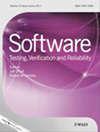自适应或嵌入式软件测试和突变测试
IF 1.2
4区 计算机科学
Q3 COMPUTER SCIENCE, SOFTWARE ENGINEERING
引用次数: 1
摘要
这期有四篇论文。第一篇论文概述了测试自适应和上下文感知系统的工作,而第二篇论文则涉及测试嵌入式系统。其余两篇论文探讨了与大多数STVR读者所熟知的领域相关的特定问题:突变检测。第一篇论文,“自适应和上下文感知系统的测试:方法和挑战”,由Bento R. Siqueira, Fabiano C. Ferrari, Kathiani E. Souza, Valter V. Camargo和rogacimrio de Lemos撰写,介绍了系统的文献综述和研究的专题分析,以表征测试自适应系统(ASs)和上下文感知系统(CASs)的最新技术,并讨论了方法,挑战,观察到的趋势以及研究的局限性和方向。作者发现了与AS和CAS测试(如测试用例和内置测试的生成)、反复出现的测试挑战(如上下文监控和运行时决策)、一些趋势(如基于模型的测试和混合技术)和一些很少调查的问题(如不确定性和变化预测)相关的反复出现的研究问题。第二篇论文,“云上的远程嵌入式设备测试框架”,作者Il-Seok (Benjamin) Choi和Chang-Sung Jeong介绍了一个名为RED-TFC的云上远程嵌入式设备测试框架,其可靠性测试管理器组件可以利用云概念自动执行各种测试,以评估分布式共享设备的可靠性和性能。RED-TFC包括两大技术:自适应样本信度测试(ASRT)和质量样本信度测试(MSRT)。作者分析了两种包含许多嵌入式组件的安卓智能手机模型,并表明RED-TFC可以帮助检测智能手机中的大量可靠性问题。Macario Polo-Usaola和Isyed Rodríguez-Trujillo撰写的第三篇论文《分析Android突变测试中成本降低技术的组合》关注的是在测试手机应用时使用突变测试。正如作者所指出的那样,在测试应用程序时,通常会在移动设备上部署应用程序及其变体,或者在模拟器上执行它们。这样做会增加测试执行时间。当然,它也会显著增加突变检测的成本,尤其是在存在许多突变的情况下。作者研究了几种用于减少突变测试执行时间的技术,并建立了一个数学模型,以预测使用这些技术的某些组合所花费的时间。最后一篇论文是Alireza Aghamohammadi和Seyed-Hassan Mirian-Hosseinabadi的“基于集合的预测突变测试方法,考虑了未到达突变的影响”。本文还涉及突变检测和预测。然而,作者着眼于一个不同的预测问题:预测一个突变体是否会被杀死。作者注意到以前的工作没有考虑不可到达的突变的影响:那些突变点没有被任何使用的测试用例覆盖的地方。有人认为,由于许多突变工具排除了无法到达的突变体,因此这些突变体也应该从任何经验评估中删除。作者报告了重复先前研究的结果,同时也消除了无法到达的突变,发现预测技术的最终性能远低于报道的结果。作者随后提出了另一种预测模型,当无法到达的突变体被移除时,该模型被证明是有效的。(推荐人:Tanja Vos)本文章由计算机程序翻译,如有差异,请以英文原文为准。
Adaptive or embedded software testing and mutation testing
This issue contains four papers. The first paper provides a survey of work on testing adaptive and context-aware systems, while the second one concerns testing embedded systems. The remaining two papers explore particular problems associated with an area well known to most STVR readers: mutation testing. The first paper, ‘Testing of adaptive and context-aware systems: Approaches and challenges’, by Bento R. Siqueira, Fabiano C. Ferrari, Kathiani E. Souza, Valter V. Camargo and Rogério de Lemos, introduces a systematic literature review and a thematic analysis of studies to characterize the state of the art in testing adaptive systems (ASs) and context-aware systems (CASs) and discuss approaches, challenges, observed trends and research limitations and directions. The authors discover recurring research concerns related to AS and CAS testing (such as generation of test cases and built-in tests), recurring testing challenges (such as context monitoring and runtime decisions), some trends (such as model-based testing and hybrid techniques) and some little investigated issues (such as uncertainty and prediction of changes). (Recommended by T.Y. Chen) The second paper, ‘Remote embedded devices test framework on the cloud’, by Il-Seok (Benjamin) Choi and Chang-Sung Jeong, introduces a remote embedded device test framework on the cloud named RED-TFC, whose reliability test manager component can automatically perform various tests for evaluating reliability and performance of distributed shared devices by utilizing the cloud concept. RED-TFC includes two major techniques: the adaptive sample scale for reliability test (ASRT) and the mass sample reliability test (MSRT). The authors analyse two Android smartphone models that include many embedded components and show that RED-TFC can help detect a high number of reliability problems in smartphones. (Recommended by Tanja Vos) The third paper, ‘Analysing the combination of cost reduction techniques in Android mutation testing’, by Macario Polo-Usaola and Isyed Rodríguez-Trujillo, concerns the use of mutation testing when testing mobile apps. As the authors note, when testing an app, one typically deploys the app and its mutants on mobile devices or executes them on an emulator. Doing so increases the test execution time. Naturally, it can also significantly increase the cost of mutation testing, especially when there are many mutants. The authors investigate several techniques that have been devised for reducing execution time in mutation testing and produce a mathematical model with the aim of predicting the time taken when some combination of these techniques is used. (Recommended by Mike Papadakis) The final paper is ‘An ensemble-based predictive mutation testing approach that considers impact of unreached mutants’ by Alireza Aghamohammadi and Seyed-Hassan Mirian-Hosseinabadi. This paper also concerns both mutation testing and prediction. However, the authors look at a different prediction problem: that of predicting whether a mutant will be killed. The authors note that previous work did not consider the impact of unreachable mutants: those where the mutation point is not covered by any of the test cases used. It is argued that since many mutation tools exclude unreachable mutants, such mutants should also be removed from any empirical evaluation. The authors report the results of replicating previous studies but also eliminating unreachable mutants, finding that the resultant performance of prediction techniques is far lower than that reported. The authors then propose an alternative prediction model, which is shown to be effective when unreachable mutants are removed. (Recommended by Tanja Vos)
求助全文
通过发布文献求助,成功后即可免费获取论文全文。
去求助
来源期刊

Software Testing Verification & Reliability
工程技术-计算机:软件工程
CiteScore
3.70
自引率
0.00%
发文量
34
审稿时长
>12 weeks
期刊介绍:
The journal is the premier outlet for research results on the subjects of testing, verification and reliability. Readers will find useful research on issues pertaining to building better software and evaluating it.
The journal is unique in its emphasis on theoretical foundations and applications to real-world software development. The balance of theory, empirical work, and practical applications provide readers with better techniques for testing, verifying and improving the reliability of software.
The journal targets researchers, practitioners, educators and students that have a vested interest in results generated by high-quality testing, verification and reliability modeling and evaluation of software. Topics of special interest include, but are not limited to:
-New criteria for software testing and verification
-Application of existing software testing and verification techniques to new types of software, including web applications, web services, embedded software, aspect-oriented software, and software architectures
-Model based testing
-Formal verification techniques such as model-checking
-Comparison of testing and verification techniques
-Measurement of and metrics for testing, verification and reliability
-Industrial experience with cutting edge techniques
-Descriptions and evaluations of commercial and open-source software testing tools
-Reliability modeling, measurement and application
-Testing and verification of software security
-Automated test data generation
-Process issues and methods
-Non-functional testing
 求助内容:
求助内容: 应助结果提醒方式:
应助结果提醒方式:


